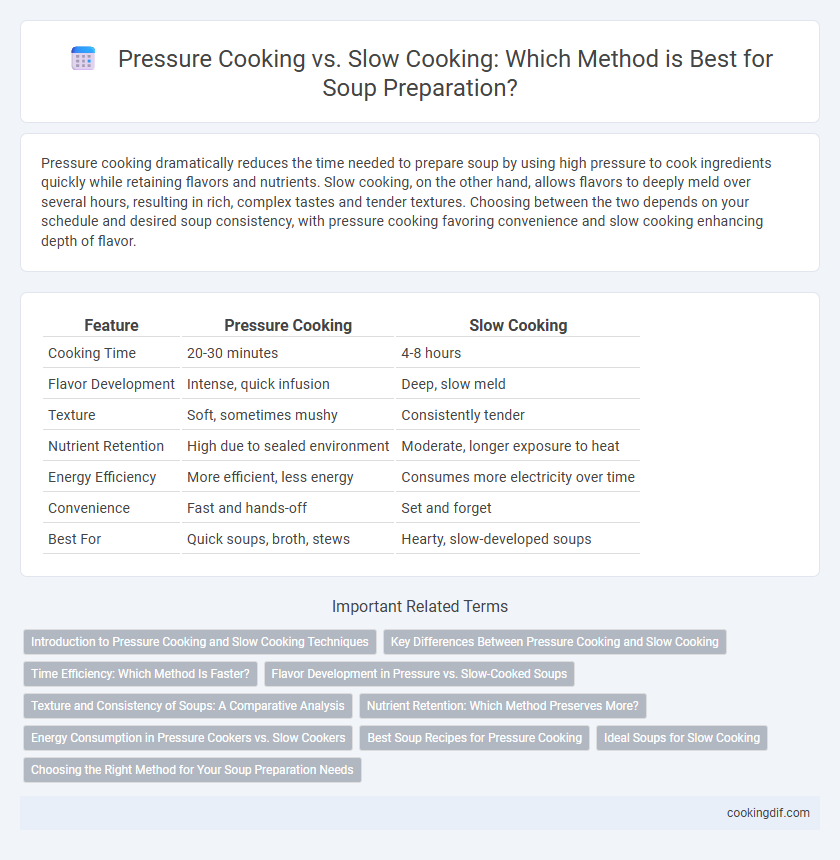Pressure cooking dramatically reduces the time needed to prepare soup by using high pressure to cook ingredients quickly while retaining flavors and nutrients. Slow cooking, on the other hand, allows flavors to deeply meld over several hours, resulting in rich, complex tastes and tender textures. Choosing between the two depends on your schedule and desired soup consistency, with pressure cooking favoring convenience and slow cooking enhancing depth of flavor.
Table of Comparison
| Feature | Pressure Cooking | Slow Cooking |
|---|---|---|
| Cooking Time | 20-30 minutes | 4-8 hours |
| Flavor Development | Intense, quick infusion | Deep, slow meld |
| Texture | Soft, sometimes mushy | Consistently tender |
| Nutrient Retention | High due to sealed environment | Moderate, longer exposure to heat |
| Energy Efficiency | More efficient, less energy | Consumes more electricity over time |
| Convenience | Fast and hands-off | Set and forget |
| Best For | Quick soups, broth, stews | Hearty, slow-developed soups |
Introduction to Pressure Cooking and Slow Cooking Techniques
Pressure cooking uses high-temperature steam under sealed conditions to rapidly cook soups, preserving nutrients and intensifying flavors in a fraction of the time compared to traditional methods. Slow cooking gently simmers ingredients over extended periods at low temperatures, allowing flavors to meld deeply and textures to become tender without constant supervision. Both techniques offer distinct advantages: pressure cooking excels in speed and nutrient retention, while slow cooking enhances flavor development and convenience.
Key Differences Between Pressure Cooking and Slow Cooking
Pressure cooking uses high heat and steam to cook soups rapidly, preserving nutrients and intensifying flavors within minutes, while slow cooking employs low, steady heat over several hours, allowing flavors to meld gently and ingredients to become tender. Pressure cookers are ideal for quick meal preparation and when time is limited, whereas slow cookers excel in developing deep, complex flavors with minimal supervision. The key differences lie in cooking time, temperature, and flavor extraction, with pressure cooking offering speed and efficiency, and slow cooking prioritizing gradual flavor infusion and texture enhancement.
Time Efficiency: Which Method Is Faster?
Pressure cooking significantly reduces soup preparation time by using high steam pressure to cook ingredients quickly, often cutting cooking durations from hours to under an hour. Slow cooking, while enhancing flavor development through extended simmering, typically requires 6 to 8 hours or more to achieve similar results. For time efficiency, pressure cooking is the superior method, delivering soups faster without compromising texture or taste.
Flavor Development in Pressure vs. Slow-Cooked Soups
Pressure cooking soups accelerates flavor extraction by using high heat and steam, intensifying aromas and tenderizing ingredients rapidly. Slow cooking allows gradual melding of flavors, resulting in richer, deeper taste profiles that develop complexity over hours. While pressure cooking saves time, slow cooking enhances subtle spice and herb infusions, making each method distinct in flavor development.
Texture and Consistency of Soups: A Comparative Analysis
Pressure cooking intensifies heat and steam, breaking down ingredients rapidly to produce soups with a rich, concentrated texture and smooth consistency. Slow cooking allows gradual ingredient melding, resulting in soups with tender chunks and a more layered, hearty texture. Both methods impact thickness differently: pressure cooking can thicken through reduction, while slow cooking enhances viscosity through prolonged starch release.
Nutrient Retention: Which Method Preserves More?
Pressure cooking preserves more nutrients in soup compared to slow cooking due to shorter cooking times and higher steam pressure that quickly breaks down food while retaining vitamins and minerals. Slow cooking involves prolonged heat exposure, which can degrade nutrient content, especially heat-sensitive vitamins like vitamin C and some B vitamins. Studies show pressure-cooked soups retain up to 30% more nutrients than those prepared with slow cooking methods.
Energy Consumption in Pressure Cookers vs. Slow Cookers
Pressure cookers use significantly less energy than slow cookers by reducing cooking time through high-pressure steam, often completing soups in under an hour compared to slow cookers that can operate for 6 to 8 hours or more. Slow cookers maintain a low, steady temperature over extended periods, leading to higher cumulative energy consumption despite lower wattage. Energy-efficient models of pressure cookers can save up to 70% of energy when preparing soups, making them a more sustainable choice for quick and eco-friendly meal preparation.
Best Soup Recipes for Pressure Cooking
Pressure cooking accelerates the soup-making process by using high steam pressure, which extracts deep flavors from ingredients in a fraction of the time compared to slow cooking. Best soup recipes for pressure cooking often include rich broths, hearty beans, and tough cuts of meat that benefit from the intense, fast cooking environment, producing tender textures and well-integrated flavors. Pressure cookers also preserve nutrients better and reduce energy consumption, making them ideal for preparing nutritious, flavorful soups efficiently.
Ideal Soups for Slow Cooking
Slow cooking is ideal for hearty soups with root vegetables, beans, and tougher cuts of meat that benefit from prolonged simmering to develop deep, rich flavors and tender textures. Classic options include beef stew, chicken noodle, and lentil soups, where slow cooking enhances the melding of spices and ingredients. Pressure cooking, while faster, may not achieve the same depth of flavor and texture complexity found in slow-cooked soups.
Choosing the Right Method for Your Soup Preparation Needs
Pressure cooking accelerates soup preparation by using high heat and steam to extract flavors quickly, ideal for hearty stocks and tough ingredients. Slow cooking gently simmers soups over extended periods, enhancing depth and richness, perfect for delicate vegetables and complex flavors. Selecting the right method depends on your time availability and desired flavor intensity, ensuring optimal texture and nutrient retention for your soup.
Pressure Cooking vs Slow Cooking for preparation Infographic

 cookingdif.com
cookingdif.com